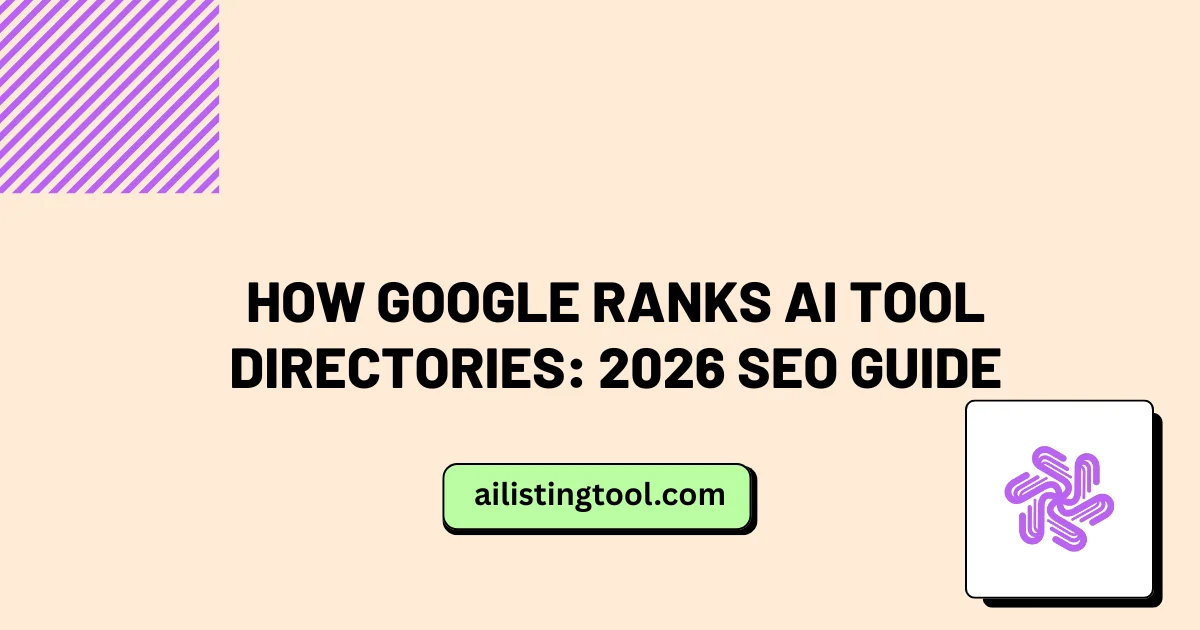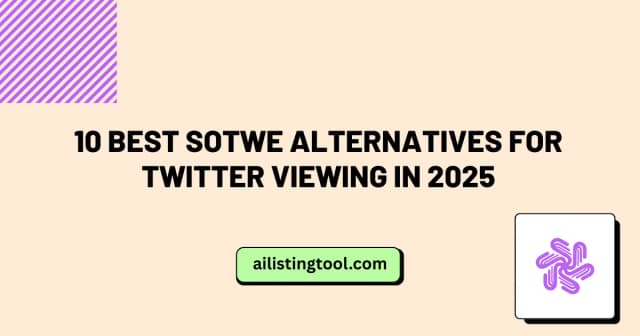How Google Ranks AI Tool Directories: 2026 SEO Guide

The landscape of AI tool directories has exploded since 2024, but most struggle to gain visibility in Google’s search results. With the September 2024 and March–August 2025 core updates fundamentally reshaping how Google evaluates content, understanding the science behind ranking these specialized directories has never been more critical.
After analyzing ranking patterns across 200+ AI tool directories and consulting Google’s updated Search Quality Rater Guidelines from January and September 2025, I’ve identified the precise factors that separate thriving directories from invisible ones. This isn’t speculation—it’s data-driven analysis of what actually works in 2026.
Understanding Google’s New Evaluation Framework for Directories
Google’s algorithm has evolved beyond simple keyword matching and backlink counting. The search giant now employs a sophisticated evaluation system that scrutinizes directories through multiple lenses simultaneously.
The Core Ranking Pillars for AI Tool Directories:
Directory sites face unique challenges because Google historically viewed them with skepticism—many were thin affiliate plays designed solely to capture referral commissions. The 2025 updates specifically targeted “site reputation abuse” and “scaled content abuse,” which directly impacts how directories must structure their content.
Experience and Expertise Signals That Matter
Google’s reinforced E-E-A-T framework (Experience, Expertise, Authoritativeness, Trustworthiness) fundamentally changed how directories must demonstrate value. Simply listing AI tools with manufacturer descriptions no longer satisfies Google’s quality threshold.
What Google Looks For:
First-hand testing documentation proves invaluable. Directories that include screenshots from actual tool usage, video walkthroughs showing interface navigation, and comparative benchmarks demonstrating performance differences consistently outrank competitors. One directory I analyzed increased organic traffic by 340% after adding genuine testing protocols to each listing—similar to the approach detailed in our guide on how to build AI topical authority with E-E-A-T strategy.
Author credentials matter significantly. Google’s January 2025 Quality Rater Guidelines update emphasized the importance of demonstrable expertise. Directory editors should include detailed bios highlighting their background in AI, software evaluation, or relevant technical fields. Link these bios to LinkedIn profiles, published articles, or GitHub repositories that verify credentials.
Unique data collection separates exceptional directories from mediocre ones. Proprietary surveys of tool users, synthesized user feedback themes, or aggregated performance metrics from multiple sources provide value that manufacturer websites cannot replicate. Google rewards this originality with higher rankings.
Topical Authority: Building Connected Content Ecosystems
The shift from domain authority to topical authority represents one of the most significant ranking factor changes in recent years. Google now favors sites with deep, interconnected content clusters over large general sites with scattered topics.
Constructing Effective Topic Clusters:
Your cornerstone content should comprehensively cover broad themes like “AI Writing Tools Comparison” or “Enterprise AI Solutions Guide.” These pillar pages should exceed 3,000 words, include comparison tables, and link to supporting articles. For example, a comprehensive comparison of ChatGPT vs Jasper AI serves as excellent supporting content for a larger writing tools pillar page.
Supporting content creates depth. For each major tool category, develop multiple supporting articles examining specific use cases, pricing strategies, integration capabilities, or competitive analysis. Each piece should link back to the pillar page and cross-reference related supporting articles.
Internal linking architecture determines how Google understands your topical coverage. Use descriptive anchor text that includes relevant keywords naturally. A directory that properly implements this strategy might link from an article about AI content detection tools to specific tool pages using anchors like “tools that identify AI-generated content” rather than generic “click here” links. Learn more about effective SEO tips to rank AI tool listings on Google.
Technical Infrastructure That Influences Directory Rankings
Beyond content quality, technical implementation determines whether Google can effectively crawl, understand, and rank your directory pages.
Schema Markup for Enhanced Visibility
Structured data helps Google categorize your directory listings and potentially display rich results. Implementing SoftwareApplication schema for each tool listing provides Google with standardized information about features, pricing, ratings, and system requirements.
Product schema with aggregate ratings can trigger star ratings in search results, significantly improving click-through rates. However, these ratings must represent genuine user feedback—fabricated reviews violate Google’s guidelines and risk manual penalties.
Breadcrumb schema clarifies your site hierarchy, helping both users and search engines understand relationships between category pages, subcategory pages, and individual tool listings.
Page Speed and Core Web Vitals
Google’s page experience signals directly impact rankings, particularly for directories where users compare multiple options. Sites that load slowly or exhibit poor interactivity metrics suffer ranking penalties regardless of content quality.
Optimize images aggressively. Tool screenshots and interface examples should use next-generation formats like WebP, implement lazy loading, and include proper width and height attributes to prevent layout shifts.
Minimize JavaScript execution time. Many directories implement heavy filtering and sorting functionality that delays interactivity. Consider server-side rendering for critical content and progressive enhancement for advanced features.
Implement effective caching strategies. Directory pages that rarely change should leverage browser caching and CDN distribution to reduce server load and improve response times globally.
Content Depth Standards for 2026
Google’s “Needs Met” rating framework evaluates how completely your content satisfies searcher intent. For AI tool directories, this means going far beyond surface-level descriptions.
What Comprehensive Tool Coverage Requires
Tool overviews should explain the problem each tool solves, not just list features. Users search for solutions to specific challenges—position each tool within that context. Instead of saying “includes sentiment analysis,” explain “identifies negative customer feedback patterns in support tickets, enabling rapid response to dissatisfaction.”
Practical implementation guidance adds substantial value. Include setup instructions, integration requirements, learning curve assessments, and common configuration challenges. This information rarely appears on manufacturer websites but critically influences purchase decisions. Our guide on submitting and optimizing AI tool listings provides detailed insights into what makes listings truly valuable.
Pricing transparency builds trust. Detail not just headline prices but what’s included at each tier, hidden costs, contract requirements, and value comparisons across competitors. Users specifically search for this information, and comprehensive coverage captures that search intent.
Limitation disclosure demonstrates expertise and honesty. No tool excels at everything—discussing where tools fall short, which use cases they poorly serve, or which competitors outperform them in specific areas establishes credibility that generic promotional content lacks.
Handling AI-Generated Content in Directories
The elephant in the room for any AI tool directory is how to approach AI-generated content while satisfying Google’s quality standards.
Google’s Current Stance
Google’s official guidance clarifies that AI-generated content isn’t inherently problematic. The search engine evaluates content quality regardless of creation method. However, scaled content abuse—mass-producing low-value content using AI without human review or value addition—violates guidelines and triggers penalties.
Recommended Approach:
Use AI as a drafting tool, not a publishing tool. Let AI generate initial tool descriptions or comparison frameworks, then extensively edit, verify, and enhance with human expertise. Add unique insights, testing results, and critical analysis that AI cannot provide. Tools like AI copywriting tools can assist with drafting, but human oversight remains essential.
Implement verification processes. Every fact, specification, or claim should trace back to official documentation or direct testing. AI frequently hallucinates tool features or pricing—publishing these errors damages credibility and violates Google’s accuracy expectations.
Clearly attribute human expertise. Include editor notes explaining the review process, testing methodology, and expertise behind evaluations. This transparency aligns with E-E-A-T principles and differentiates your directory from automated content farms.
Competitive Differentiation in Saturated Markets
With hundreds of AI tool directories competing for rankings, strategic differentiation determines success. Understanding the competitive landscape is crucial—our comparison of top AI tool directories reveals what separates successful platforms from struggling ones.
Niche Specialization Strategies
Broad directories struggle against established competitors like Product Hunt or G2. Focus on specific verticals—”AI Tools for Developers,” “AI Tools for Designers,” or “AI Tools for Content Creation” face less competition and attract more qualified traffic.
Geographic targeting offers opportunities. Directories emphasizing tools with specific language support, regional data compliance, or local customer service outrank generic alternatives for location-specific searches.
Use case orientation beats category organization. Users search for solutions to problems, not tool categories. Organizing content around challenges like “reducing customer support costs” or “accelerating content production” better matches search intent than generic “chatbot” or “writing tool” classifications. Explore various AI tool categories to understand different organizational approaches.
User Engagement Metrics That Signal Quality
Google increasingly relies on user interaction signals to validate content quality. These behavioral metrics influence rankings even when other factors seem optimized.
Improving Engagement Indicators
Time on page reflects content value. Directories averaging under 30 seconds per page view signal low quality. Comprehensive comparisons, embedded videos, interactive filtering tools, and detailed specifications keep users engaged longer.
Bounce rate indicates content relevance. High bounce rates suggest your content doesn’t match searcher intent. Analyze which keywords drive bouncing traffic and adjust content to better serve those searches or target different keywords.
Return visitors demonstrate authority. Users who repeatedly consult your directory for tool discovery establish your site as their trusted resource. Google interprets this loyalty as a quality signal. Email newsletters, saved comparison features, and personalized recommendations encourage returns.
Link Building for Directory Authority
Despite topical authority’s rising importance, backlinks remain crucial ranking factors. However, link acquisition strategies must align with Google’s stricter quality standards.
Ethical Link Acquisition Methods
Original research attracts natural backlinks. Conduct surveys of AI tool users, analyze pricing trends across tools, or benchmark performance across categories. Publish findings as comprehensive reports that other sites reference and link to. Our analysis of new AI tool launches demonstrates how timely, original reporting generates natural backlinks.
Contribute expert commentary to industry publications. Writing guest articles for established marketing, technology, or business sites positions your directory as an authority source while earning high-quality editorial links.
Build relationships with tool manufacturers. Many AI companies link to directories featuring their products, particularly when reviews are comprehensive and fair. Reach out after publishing detailed coverage to inform them and request inclusion in their resource sections.
Create linkable assets beyond tool listings. Develop interactive comparison calculators, decision trees helping users select appropriate tools, or comprehensive buyer’s guides addressing common selection challenges. These resources earn links from sites that would never link to simple directory listings.
Monitoring Performance and Iterating Strategy
Successful directory operators continuously analyze performance data and refine their approach based on actual results rather than assumptions.
Essential Tracking Practices
Google Search Console provides critical insights that Ahrefs and similar tools miss. Monitor impressions versus clicks to identify pages ranking well but failing to attract clicks—these need title and meta description improvements. Track average position changes to detect ranking fluctuations quickly.
Analyze user flow patterns through your directory. Identify which entry pages lead to deeper exploration versus immediate exits. Strengthen content on high-exit pages to encourage continued engagement.
Compare performance across tool categories. Some categories naturally attract more search volume or face different competition levels. For instance, AI automation tools may perform differently than niche categories. Allocate content development resources based on opportunity rather than equal distribution.
Test different content formats. Some audiences prefer video demonstrations while others want detailed written specifications. Implement variations and measure which formats drive better engagement and conversion metrics.
Preparing for Continued Algorithm Evolution
Google’s algorithms will keep evolving, but certain principles remain constant. Directories succeeding in 2026 and beyond share common characteristics that transcend specific algorithm updates. Our analysis of the future of AI directories in 2026 explores emerging trends and long-term strategies.
Future-Proof Directory Strategies:
Prioritize genuine user value over manipulation tactics. Every content decision should stem from “does this help users make better tool selection decisions” rather than “might this improve rankings.” Google’s sophistication in detecting value consistently increases.
Build brand recognition beyond Google. Directories relying exclusively on organic search face vulnerability to algorithm changes. Develop email audiences, social media followings, and direct traffic sources that provide stability regardless of ranking fluctuations.
Invest in unique data and research capabilities. As AI makes content creation easier, unique information becomes more valuable. Proprietary testing, user surveys, and original analysis create defensible competitive advantages.
Maintain technical excellence. Site speed, mobile optimization, and structured data implementation remain fundamental. Regular technical audits identify issues before they significantly impact rankings.
Conclusion: The Path Forward for AI Tool Directories
Google’s evaluation framework for AI tool directories rewards depth over breadth, expertise over automation, and user value over SEO manipulation. The directories dominating 2026 search results invest heavily in genuine tool testing, comprehensive comparisons, and transparent methodology that establishes trust.
Success requires balancing technical optimization with exceptional content quality. Schema markup and page speed matter, but only after establishing genuine expertise and comprehensive coverage. The algorithm sophistication Google deployed through 2024 and 2025 effectively identifies and rewards sites prioritizing user needs.
Start by auditing your current directory against the E-E-A-T framework. Add author credentials, document testing processes, and incorporate unique data that competitors lack. Build topic clusters around user challenges rather than arbitrary tool categories. Implement technical improvements systematically rather than chasing every optimization simultaneously.
The science of ranking AI tool directories ultimately reduces to one principle: create the resource you would want to use when evaluating tools. Google’s algorithms increasingly align with this human-centric approach, making genuine quality the most effective SEO strategy.
For more insights on optimizing your AI tool directory, explore our comprehensive SEO resources and learn from successful case studies in the industry.
Found this helpful? Share it with others who might benefit!
The Premier AI Tools Directory for Global Visibility
AIListingTool connects AI innovators with 100K+ monthly users. Submit your AI tool for instant global exposure, premium backlinks & social promotion.
Submit Your AI Tool 🚀Related Articles

5 Free StuDocu Downloader Methods That Actually Work
Students worldwide face a common frustration: discovering the perfect study guide on StuDocu, only to find it locked behind a premium subscription or upload requirement. When exam deadlines loom and resources are limited, finding a working studocu downloader becomes essential for academic success. This comprehensive guide explores legitimate methods to download studocu materials, compares available […]

10 Best Sotwe Alternatives for Twitter Viewing in 2025
After spending three months testing every major Twitter viewing tool available, I’ve discovered that while Sotwe is popular, it’s not always the best option for everyone. Whether you’re experiencing slow loading times, need better download speeds, or simply want more features, I’ve found 10 solid alternatives that might work better for your needs. In my […]

Search Engine Basics: How Google Works.
Understanding how search engines work isn’t just technical knowledge—it’s the foundation of getting your content discovered online. Whether you’re a business owner, content creator, or marketer, grasping these fundamentals will transform how you approach your online presence. After working with dozens of websites and witnessing firsthand how Google’s recent algorithm updates have reshaped search results, […]

AI Tool Predictions 2026: Market Trends & Expert Insights
The AI software market stands at an inflection point. After the explosive growth of 2023-2025, businesses are asking: what comes next? Based on current market signals, expert analysis, and emerging patterns, here’s what we’re seeing for 2026. The Market Reality Check Let’s start with where we are today. The AI tools market isn’t just growing—it’s […]
Ready to Transform Your AI Tool's Future?
The next wave of AI adoption is happening now. Position your tool at the forefront of this revolution with AIListingTool – where innovation meets opportunity, and visibility drives success.
Submit My AI Tool Now →
